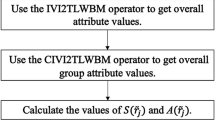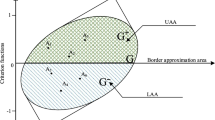Abstract
The theory of D numbers (DNs) is an extension of Dempster–Shafer (D–S) evidence theory. Linguistic DNs (LDNs) combine the advantages of the linguistic terms (LTs) and DNs, and can express the uncertain and incomplete information more easily and precisely in decision-making. In addition, the Bonferroni mean (BM) operator and the TOPSIS method are both useful tools to address multiple-attribute group decision-making (MAGDM) problems. Then, in this paper, we extend the BM operator based on the new defined operational rules of LDNs to propose the linguistic D number arithmetic Bonferroni mean (LDABM) operator and the linguistic D number weighted arithmetic Bonferroni mean (LDWABM) operator. We also integrate the proposed LDWABM operator and the TOPSIS method, and further establish a novel method to address MAGDM problems. Finally, we use the proposed method to solve the practical problems of investment decision-making and materials supplier selection and then we prove the feasibility and the superiority of the proposed method by comparing with other methods.


Similar content being viewed by others
References
Bhatt D, Babu SR, Chudgar HS (2017) A novel approach towards utilizing Dempster Shafer fusion theory to enhance WiFi positioning system accuracy. Pervasive Mob Comput 37:115–123
Bonferroni C (1950) Sulle medie multiple di potenze. Bolletino Matematica Italiana 5:267–270
Dempster AP (1967) Upper and lower probabilities induced by a multi-valued mapping. Ann Math Stat 38(2):325–339
Deng Y (2012) D numbers: theory and applications. J Inf Comput Sci 9(9):2421–2428
Deng X, Deng Y (2019) D-AHP method with different credibility of information. Soft Comput 23(2):683–691
Dutta B, Guha D (2015) Partitioned Bonferroni mean based on linguistic 2-tuple for dealing with multi-attribute group decision making. Appl Soft Comput 37:166–179
Fan GC, Zhong DH, Yan FG, Yue P (2016) A hybrid fuzzy evaluation method for curtain grouting efficiency assessment based on an AHP method extended by D numbers. Expert Syst Appl 44:289–303
Fei L, Hu Y, Xiao F, Chen L, Deng Y (2016) A modified TOPSIS method based on D numbers and its application in human resource selection. Math Probl Eng 3:1–14
Han X, Chen X (2014) A D-VIKOR method for medicine provider selection. International Joint Conference on Computational Sciences and Optimization, pp 419–423, Beijing. https://doi.org/10.1109/CSO.2014.87
Huang SK (2015) Multi-criteria decision making method based on prioritized weighted average operator with linguistic D numbers. J Jiamusi Univ (Natural Science Edition) 33(3):464–469
Hwang CL, Yoon KS (1981) Multiple attribute decision methods and applications. Springer, Berlin
Jafari H, Li X, Qian L, Aved A, Kroecker T (2017) Multi-sensor change detection on the basis of big time-series data and Dempster–Shafer theory. Concurr Comput Pract Exp 29(17):e4026
Jiao Z, Gong H, Wang Y (2018) A D–S evidence theory-based relay protection system hidden failures detection method in smart grid. IEEE Trans Smart Grid 9(3):2118–2126
Jousselme AL, Grenier D, Bosse E (2001) A new distance between two bodies of evidence. Inf Fusion 2(2):91–101
Kahneman D, Tversky A (1979) Prospect theory: an analysis of decision under risk. Econometrica 47(2):263–291
Leung Y, Li R, Ji N (2017) Application of extended Dempster–Shafer theory of evidence in accident probability estimation for dangerous goods transportation. J Geogr Syst 19(3):249–271
Li Z, Wen G, Xie N (2015) An approach to fuzzy soft sets in decision making based on grey relational analysis and Dempster–Shafer theory of evidence: an application in medical diagnosis. Artif Intell Med 64(3):161–171
Li M, Hu Y, Zhang Q, Deng Y (2016a) A novel distance function of D numbers and its application in product engineering. Eng Appl Artif Intell 47:61–67
Li XH, Wang FQ, Li XZ (2016b) Intuitionistic trapezoidal fuzzy IOWA operator based on Dempster–Shafer theory and its application. Syst Eng-Theory Pract 36(11):2915–2923
Liang D, Xu Z (2017) The new extension of TOPSIS method for multiple criteria decision making with hesitant pythagorean fuzzy sets. Appl Soft Comput 60:167–179
Liang D, Xu Z, Darko AP (2017) Projection model for fusing the information of pythagorean fuzzy multi-criteria group decision making based on geometric Bonferroni mean. Int J Intell Syst 32(9):966–987
Liu P, Gao H (2019) Some intuitionistic fuzzy power bonferroni mean operators in the framework of Dempster–Shafer theory and their application to multicriteria decision making. Appl Soft Comput 85:105790
Liu P, Li H (2017) Multiple attribute decision making method based on some normal neutrosophic Bonferroni mean operators. Neural Comput Appl 28(1):179–194
Liu P, Liu J (2019a) Partitioned Bonferroni mean based on two-dimensional uncertain linguistic variables for multiattribute group decision making. Int J Intell Syst 34(2):155–187
Liu P, Liu W (2019b) Multiple-attribute group decision-making based on power Bonferroni operators of linguistic q-rung orthopair fuzzy numbers. Int J Intell Syst 34(4):652–689
Liu P, Wang P (2019) Multiple-attribute decision-making based on Archimedean Bonferroni operators of q-Rung orthopair fuzzy numbers. IEEE Trans Fuzzy Syst 27(5):834–848
Liu P, Zhang X (2019) A multicriteria decision-making approach with linguistic D numbers based on the Choquet integral. Cogn Comput 11(4):560–575
Liu P, Chen SM, Liu J (2017) Multiple attribute group decision making based on intuitionistic fuzzy interaction partitioned Bonferroni mean operators. Inf Sci 411:98–121
Liu P, Gao H, Ma J (2019) Novel green supplier selection method by combining quality function deployment with partitioned Bonferroni mean operator in interval type-2 fuzzy environment. Inf Sci 490:292–316
Sahin A, Yapici PN (2017) Evaluation of life quality by integrated method of AHP and TOPSIS based on interval type-2 fuzzy sets. Hacettepe J Math Stat 46(3):511–523
Shafer G (1976) A mathematical theory of evidence. Princeton University Press, Princeton
Wang CY, Chen SM (2017) Multiple attribute decision making based on interval-valued intuitionistic fuzzy sets, linear programming methodology, and the extended TOPSIS method. Inf Sci 397:155–167
Wang J, Huang S (2016) Multi-criteria decision making method based on fuzzy entropy and evidential reasoning with linguistic D numbers. Control Decis 31(4):673–677
Wang N, Wei D (2016) Uncertain multi-attribute decision making method based on D numbers. J Hubei Univ Natl 34(1):35–39
Wang J, Wu J, Zhang H, Chen X (2016a) Multi-criteria decision-making methods based on the Hausdorff distance of hesitant fuzzy linguistic numbers. Soft Comput 20(4):1621–1633
Wang NK, Liu XM, Wei DJ (2016b) A modified combination rule for D numbers theory. Math Probl Eng 2:1–10
Wang NK, Liu XM, Wei DJ (2018) A modified D numbers’ integration for multiple attributes decision making. Int J Fuzzy Syst 20(5):104–115
Wei G (2016) Picture 2-Tuple linguistic Bonferroni mean operators and their application to multiple attribute decision making. Int J Fuzzy Syst 19(4):201–214
Xia J, Feng Y, Liu L et al (2019) On entropy function and reliability indicator for D numbers. Appl Intell 49(4):3248–3266
Xiao F (2019) A multiple-criteria decision-making method based on D numbers and belief entropy. Int J Fuzzy Syst 21(4):1144–1153
Yager RR (2009) On generalized Bonferroni mean operators for multi-criteria aggregation. Int J Approx Reason 50:1279–1286
Yan JL (2015) Emergency Materials supplier evaluation method research based on D number and LINMAP, Dissertation, Beijing Institute of Technology
Yang C, Pu J, Deng Y, Liu Z, Liang L (2017) Salient object detection in complex scenes via D-S evidence theory based region classification. Vis Comput 33(11):1415–1428
Zhu B, Xu Z, Xia M (2010) Hesitant fuzzy geometric Bonferroni means. Inf Sci 205(1):72–85
Acknowledgements
This paper is supported by the National Natural Science Foundation of China (No. 71771140), the Special Funds of Taishan Scholars Project of Shandong Province (No. ts201511045), and Major bidding projects of National Social Science Fund of China (19ZDA080),  (Project of cultural masters and “the four kinds of a batch” talents).
(Project of cultural masters and “the four kinds of a batch” talents).
Author information
Authors and Affiliations
Corresponding author
Ethics declarations
Conflict of interests
We declare that we do have no commercial or associative interests that represent a conflict of interests in connection with this manuscript. There are no professional or other personal interest that can inappropriately influence our submitted work.
Additional information
Communicated by Rosana Sueli da Motta Jafelice.
Publisher's Note
Springer Nature remains neutral with regard to jurisdictional claims in published maps and institutional affiliations.
Rights and permissions
About this article
Cite this article
Liu, P., Zhang, X. A novel approach to multi-criteria group decision-making problems based on linguistic D numbers. Comp. Appl. Math. 39, 132 (2020). https://doi.org/10.1007/s40314-020-1132-x
Received:
Revised:
Accepted:
Published:
DOI: https://doi.org/10.1007/s40314-020-1132-x




